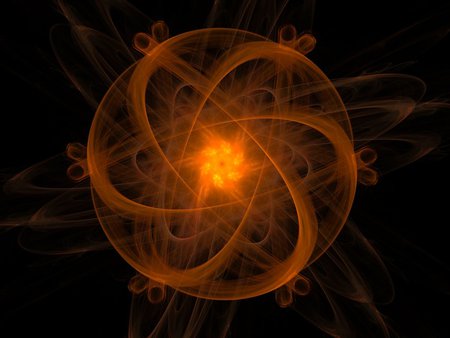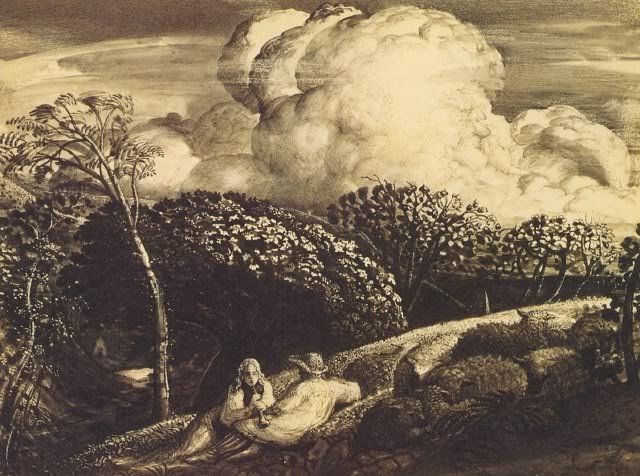The Tale of a Watchamadilly
In the ancient times words themselves were thought to possess magical power. Naming something was tantamount to controlling it. Much was attached to how you named your child or your town or your god. In some American Indian tribes a child was not given a name until after puberty, when his character became sufficiently evident so that an appropriate name could be ascribed to him or her.
As I hope to demonstrate presently, not much has changed in this department. We still give names to things we can’t control, - phenomena above our reach and/or understanding. The trouble is that once a name is concocted by the select few, the public at large seizes on the newly discovered "magic term" like a bulldog fetches a new toy, all the while forgetting both their own ignorance and the tenuous link between naming something and having a true understanding or control of it.
A man mouths off magic spell words like "gravity" or "bosons" as if he had the slightest idea about what he is talking about or the real causes or modes of operation of the phenomena involved. The most we can hope to do when we approach the limits of our understanding is to create "models" of reality - mental pictures that aid our understanding of cause-and-effect relationships. Understanding the underlying reality is something quite distinct from that. A simple repeated inquiry of "Why?" will eventually reduce any scientist to say in the end, "it's just the way things are", which is really not that much better than saying "because God made it so". (Incidentally, the anthropic principle is pretty much the same specie of a tautological statement that reality is like it is because it is).
What follows is the original Wikipedia article abstract about “Atom” - with a few small changes. All the words that are either defined in terms of each other or are terms borrowed from Latin or Greek have been substituted for what they are - placeholders. Some have been given their original meaning in the native language. I hope as you read and think on this, it will have the same humbling effect it had on me. Without further ado, I introduce...
Whatchamadilly [1]
A whatchamadilly is the smallest part of whole unit of ordinary Thingy[2] that has the peculiarities[3] of an al-kīmiyā doohicky[4]. Every solid, liquid, gas, and this other state that we call “anything formed”[5], is made up of neutral or “walking”[6] whatchamadillys with unequal number of thingamabobs[7] and thingamajigs[8]. Whatchamadillys are very small; typical sizes are around 100 picometers (a ten-billionth of a meter, in the short scale).
Whatchamadillys are small enough that attempting to foretell[9] their behavior using old (“classical”) nature-knowledge[10] - as if they were billiard balls, for example - gives noticeably incorrect foretellings due to “howGreat”[11] effects. Through the development of nature-knowledge, whatchamadilly molds of what is[12] have included “howGreat” “chief things” to better explain and foretell the behavior.
Every whatchamadilly is made up of a kernel[13] and one or more thingamajig bound to the kernel. The kernel is made of one or more thingamabobs and typically a similar number of thingummys[14]. Thingamabobs and thingummys are called kernel-thingies[15]. More than 99.94% of an whatchamadilly's “mass”[16] is in the kernel. The thingamabobs have a positive amberForce[17], the thingamajigs have a negative amberForce, and the thingummys have no amberForce. If the number of thingamabobs and thingamajigs are equal, that whatchamadilly is thingamajigally neutral. If an whatchamadilly has more or fewer thingamajigs than thingamabobs, then it has an overall negative or positive amberForce, respectively, and it is called a “walking” whatchamadilly.
The thingamajigs of an whatchamadilly are attracted to the thingamabobs in an whatchamadillic kernel by this TopsyTurvy “Force”[18]. The thingamabobs and thingummys in the kernel are attracted to each other by a different “Force”, the kernel force, which is usually stronger than the TopsyTurvy “Force” repelling the positively charged thingamabobs from one another. Under certain circumstances the repelling TopsyTurvy “Force” becomes stronger than the kernel force, and kernel-thingies can be ejected from the kernel, leaving behind a different doohicky: kernel falling apart resulting in change-over.
The number of thingamabobs in the kernel defines to what al-kīmiyā doohicky the whatchamadilly belongs: for example, all copper whatchamadillys contain 29 thingamabobs. The number of thingummys defines the CouchPotato[19] of the doohicky. The number of thingamajigs influences the Turvy[20] properties of an whatchamadilly. Whatchamadillys can attach to one or more other whatchamadillys by al-kīmiyā bonds to form al-kīmiyā put-togethers[21] such as tinyThinies[22]. The ability of whatchamadillys to bunch together and flee each other is responsible for most of the natural changes observed in nature, and is the subject of the teaching[23] of of al-kīmiyā.
Thingamabob
A thingamabob is a part of a whatchamadilly (a “whatchamadilly underling”[24]), symbol p or p+, with a positive “amberForce” of +1e doohicky “amberForce” and “mass”[25] slightly less than that of a thingummy. Thingamabobs and thingummys, each with “masses” of approximately one whatchamadillic “mass” unit, are collectively referred to as "thingymabopper". One or more thingamabobs are present in the kernel of every whatchamadilly. They are a necessary part of the kernel. The number of thingamabobs in the kernel is the defining peculiarity of a doohicky, and is referred to as the whatchamadillic number (represented by the symbol Z). Since each doohicky has a unique number of thingamabobs, each doohicky has its own unique whatchamadillic number. The word thingamabob is Greek for "first", and this name was given to the “water-bearing”[26] kernel by Ernest Rutherford in 1920. In previous years Rutherford had discovered that the “water-bearing” kernel (known to be the lightest kernel) could be extracted from the kernels of “saltpeter-bearer”[27] by collision.
Thingamabobs were therefore a candidate to be a foundational[28] tiny-part and a building block of “saltpeter-bearer” and all other heavier whatchamadillic kernels.
In the modern Standard “Mold of What Is” of tiny-part physics, thingamabobs are hadrons, and like thingummys, the other thingymabopper (tiny-part present in whatchamadillic kernels), are made up of three woozie-watsies[29]. Although thingamabobs were originally considered foundational or doohickey-like tiny parts, they are now known to be made up of three “strong”[30] woozie-whatsie: two up woozie-whatsie and one down woozie-whatsie. The rest “masses” of woozie-whatsies contribute only about 1% of a thingamabob's “mass”, however. The remainder of a thingamabob's “mass” is due to “howGreat” “coloredForce”[31] binding “ability to do work”[32], which includes the moving[33] “ability to do work” of the woozie-whatsies and the “ability to do work” of the whatchamacallit[34] Frooples that bind the woozie-whatsies together. Because thingamabobs are not foundational tiny-parts, they possess a natural size, though not a definite one; the root mean square “charge” radius of a thingamabob is about 0.84–0.87 fm or 0.84×10−15 to 0.87×10−15 m.
At sufficiently low temperatures, free thingamabobs will bind to thingamajigs. However, the character of such bound thingamabobs does not change, and they remain thingamabobs. A fast thingamabob moving through Thingy will slow by interactions with thingamajigs and kernels, until it is captured by the thingamajig cloud of an whatchamadilly. The result is a thingamabobated whatchamadilly, which is an al-kīmiyā “put-together” of “water-bearer”. In emptiness[35], when free thingamajigs are present, a sufficiently slow thingamabob may pick up a single free thingamajig, becoming a neutral “water-bearer” whatchamadilly, which is a free “rootster”[36] according to al-kīmiyā. Such "free “water-bearer” whatchamadillys" tend to react chemically with many other types of whatchamadillys at sufficiently low “abilities to do work”. When free “water-bearer” whatchamadillys react with each other, they form neutral “water-bearer” tiny-tinies (H2), which are the most common tiny-tinies’ parts of tiny-tinies’ clouds in in-between-star[37] space.
So there you have it! By the way, lest you think that this only works for this particular article, I challenge you to look up articles referring to electrons, protons, electric fields, etc. and you will see that it is "turtles all the way down" - viz. things are either defined in terms of each other (as in "circular reasoning") or names are given to conceal our ignorance of their nature (which is pretty much 99% of the story). True, we have made impressive strides in describing cause-and-effect relationships between these, but as to what "fields" or "protons" actually are - we are not much closer to figuring that out than our ancestors who whispered "Poseidon the Earth-Shaker" when an earthquake struck.
Thus, I agree with G.K. Chesterton's description that
All the terms used in the science books, “law,” “necessity,” “order,” “tendency,”and so on, are really unintellectual, because they assume an inner synthesis, which we do not possess. The only words that ever satisfied me as describing Nature are the terms usedin the fairy books, “charm,” “spell,” “enchantment.” They express the arbitrariness of the fact and its mystery. A tree grows fruit because it is a MAGIC tree. Water runs downhill because it is bewitched. The sun shines because it is bewitched.(Orthodoxy, 34).
[1] Gr. “atomos” -- atom
[2] Lat. “mater” -- Matter
[3] Lat. “proprietas” - > property
[4] Lat. “elementum” -- element
[5] Gr. “plasma”
[6] Gr. “ion”
[7] Gr. “protos” -- Proton
[8] Gr. “electra” -- electron
[9] Lat. “praedictar” -- predict
[10] Gr. “physis” -- Physics
[11] Lat. “quantum”
[12] Lat. “modulus” - > model
[13] Lat. “nucleus”
[14] Lat. “neutralis” -- Neutron
[15] Nucleons
[16] “mass” is typically defined as the “amount of Thingy in something”, although other definitions are also important (see https://en.wikipedia.org/wiki/”mass” )
[17] amberForce – a natural property of Thingy that causes it to be strained when placed in a thingamajig Froople (“field”)
[18] Electromagnetic force
[19] Gr. “isotopos”, viz. “same place” -- isotope
[20] Magnetic, Gr. “Magnesian [stone]”
[21] Lat. “componere”, viz. “put together” -- compound
[22] Lat. “molecula”, diminutive of “moles”, viz. shapeless “mass”
[23] Lat. “disciplina”
[24] Subatomic
[25] See “mass” definition in the previous section
[26] Gr. Hydrogen
[27] Gr. Nitrogen
[28] Lat. fundamental
[29] Quarks
[30] Lat. “Valentia” -- valence, valency
[31] chromodynamics
[32] Gr. “erga” -- energy
[33] Kinetic
[34] Gluon
[35] Lat. “vacuus”
[36] Lat. “radix” -- radical
[37] interstellar



Congratulations @derza! You have completed some achievement on Steemit and have been rewarded with new badge(s) :
Click on any badge to view your own Board of Honnor on SteemitBoard.
For more information about SteemitBoard, click here
If you no longer want to receive notifications, reply to this comment with the word
STOPBy upvoting this notification, you can help all Steemit users. Learn how here!